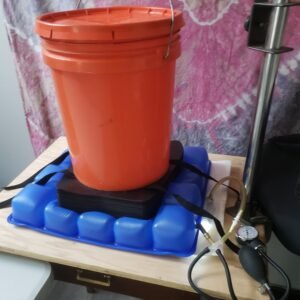Winfield Russell Matsler BA Product Design
Throughout my career I have been struggling to make a better cushion than ROHO or Star. The rubber dipped cushion is an old technology and needs to be improved upon. The most effective cushion would provide the least peak pressure against the skin. All air cushions have a minimum peak pressure against the skin, a value that is measured from the air pressure prior to bottoming out.
Optimal performance is from maximum immersion that the air cushion is capable of. The minimum air pressure to levitate oneself from bottoming out, equals the best enveloping the device can provide for tissue protection. Peak external pressure against the skin will equal the internal air pressure of the cushion.
The following is an experiment to illustrate how to measure minimum peak pressure of different air cushions by using a simple proximity sensor. 3 products were evaluated, a ROHO high profile, a Vio Comfort cushion, and a waffle cushion. I used myself and an intender to take measurements from. The data points are the least amount of pressure, in mm hg, before the subject bottoms out.
The photographs show the indenter weighing 63.8 lbs. Not shown is myself weighing 152 lbs.
A Means to Measure Minimum Peak Pressure using a indenter.
- Roho – 14 mm hg
- Vio – 18 mm hg
- Waffle – 20 mm hg
Minimum pressure to levitate with myself as a subject
- Roho – 36 mm hg
- Vio – 39 mm hg
- Waffle – 60 mm hg
This research can plainly show the performance of an air cushion and is neglected in the cushion standards. The sensor can be adapted for cushions with 2 or more inflation valves and modified to measure hybrid cushions. Easy to build and flexible, this testing should be considered in DME cushion standards and be used to show what should be used and should not be used for persons afflicted with tissue trauma.



